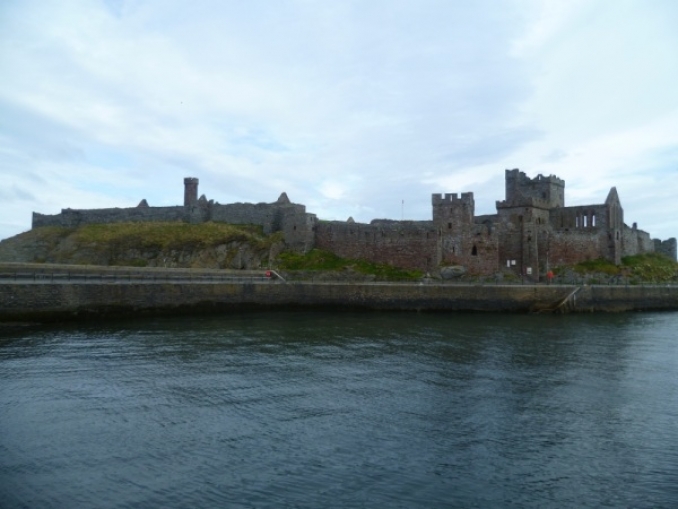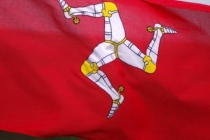Peel Castle - Cashtal Purt ny h-Inshey

The attractive and substantially preserved historical Peel Castle (Manx: Cashtal Purt ny h-Inshey) stands on St Patrick’s Isle (Manx: Ellan Noo Perick), a small island off the west coast of the Isle of Man (Manx: Mannin). It is a place with a strange magical quality where archeological studies have revealed permanent occupation on St Patrick's Isle dating to the Late Bronze Age. The Isle of Man's first known human inhabitants, were the hunter-gathering people of the Middle Stone Age. It is to Patrick’s Isle where some say St Patrick first set foot in the Isle of Man in 444 AD while returning from England to Ireland. He is then said to have appointed the Celtic missionary St German who lived from approximately 410 AD to 474 AD and oversaw further development of the Church on the Isle of Man. On the site of the Castle the remains of buildings belonging to the Celtic monastery, possibly dating from the 6-8th centuries can be seen. Dominating these remains stands the Irish style round tower; early medieval stone towers of a type found mainly in Ireland. Only three original such towers exist outside of Ireland: two in Scotland and this one on St Patrick’s Isle on the Isle of Man.
The first known fortification on St Patrick’s Isle came after the arrival in 1098 of the Viking chieftain Magnus Olafsson (Old Norse: Magnús Óláfsson), better known as Magnus Barefoot who was King Magnus III of Norway from 1093 until his death in 1103 and also King of Mann and the Isles from 1099 to 1103. He was called Magnus Barefoot/Barelegs due his adoption of Gaelic type clothing leaving the legs bare. Magnus campaigned around the Irish Sea from 1098 to 1099. The medieval Chronicles of the Kings of Mann and the Isles tell us that he saw to the erection of two wooden prefabricated forts, one now believed to be in the South of the Isle of Man and the other on St Patrick’s Isle. Other buildings still visible on the Isle are the 13th century cathedral of St German and later buildings allied to it, as well as medieval armory and barracks. These are protected by fortifications consisting of 14th century flanking towers, linked by 15th century curtain walls. More recent military construction took place in the early 19th century during the Napoleonic wars and later in the 1860s during the time of Napoleon III.
The town of Peel or as it is known to the Gaelic speaking Manx Purt ny h-Inshey (Harbour of the Island) grew up on the right bank of the River Neb (Manx: Awin Neb), facing the walls of the fortification on St Patrick's Isle. The name in English of the town Peel, could have been taken from a defensive fence or paling, but more probably from the keep at the castle's main entrance, a type of building known as a 'peel tower'. Set as it is on St Patrick’s Isle, there is no doubt that Peel Castle is a magnificent fortress. It is place of great beauty especially when framed by still blue waters and sky on a clear, calm day. It is a favourite place from which to watch the sunset over the hills of Ireland to the west. However, the mood of the Irish Sea can change quickly. When the skies grow black and the sea is whipped into a frenzy the castle looks dark and foreboding. Like any good castle worth its salt there are stories that it is haunted. Not only by sprits of humans, but also a fierce black dog known in Manx as the Moddey Dhoo.
There has been a history of burials on St Patrick's Isle over many centuries, both before and after the Viking Age. Excavations in the 1980's led to the disovery of pagan graves from the Viking period. One of them was of a female, burried at around 950 AD. She was buried with a number of items that have resulted in it being considered to the richest Viking Age female burial in the British and Irish Isles and outside of Scandinavia. She has become known as The Pagan Lady of Peel. The woman was buried with a fine and rare necklace made up 73 glass beads sculptured from stones from over a wide area of Europe Europe and the Middle east.
There were also a number of other items and various charms buried with her. Including two pieces of stone which looked like a tiny pestle and mortar and she also had a long iron rod down by her side. An iron cooking spit had been placed by her side. It had been wrapped in woollen cloth. Goose feathers were found on the spit. Other items buried with her included knives, a pair of shears used for cutting cloth, and a leather and bronze pouch. It is clear that this is a of grave of a wealthy woman, but the range of other items found with her suggest that this could also be the final resting ground for a wise woman. A woman that would have dispensed advice and could have been seen by her local community as having special powers. The Pagan Lady of Peel only adds to the magical quality and mystery of Cashtal Purt ny h-Inshey - Peel Castle.
Our visit
Our visit to Peel was very pleasant. A warm sunny day with the golden sands of the beach lying across the entrance to the harbour to the east of the Castle. We walked around St Patrick's Isle on which the Castle stands forming a natural defence. The hill and pathways up to Corrins Tower south of the Castle give great views over the town and surrounding coastline.
Getting there
Peel is on the west coast of the Isle of Man along the A1 west from the village of St John’s and Tynwald Hill and north from Glen Maye along the A27. The castle is on St Patrick’s Isle which is joined to the west of Peel harbour by a causeway.
Read More
Celtic nation:
- Isle of Man
Itinerary:
- Isle of Man - west of island
Place type:
- Castle














